2016 Peugeot 508 fuel tank capacity
[x] Cancel search: fuel tank capacityPage 202 of 371
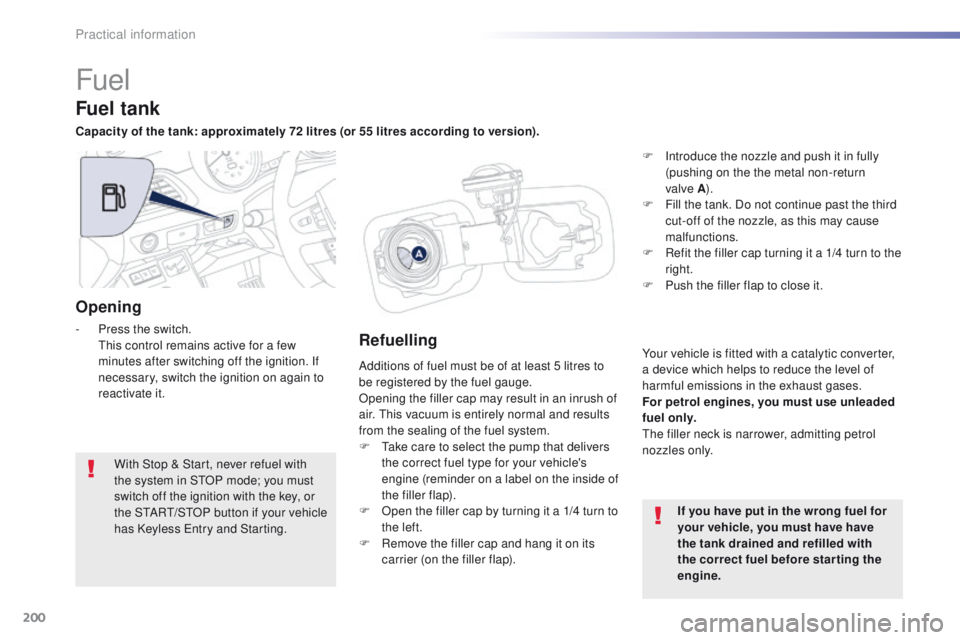
200
508_en_Chap07_info-pratiques_ed01-2016
Fuel
Additions of fuel must be of at least 5 litres to
be registered by the fuel gauge.
Opening the filler cap may result in an inrush of
air. t
h
is vacuum is entirely normal and results
from the sealing of the fuel system.
F
t
a
ke care to select the pump that delivers
the correct fuel type for your vehicle's
engine (reminder on a label on the inside of
the filler flap).
F
O
pen the filler cap by turning it a 1/4 turn to
the left.
F
R
emove the filler cap and hang it on its
carrier (on the filler flap).
Fuel tank
Capacity of the tank: approximately 72 litres (or 55 litres according to version).
If you have put in the wrong fuel for
your vehicle, you must have have
the tank drained and refilled with
the correct fuel before starting the
engine.
With Stop & Start, never refuel with
the system in S
tO
P mode; you must
switch off the ignition with the key, or
the S
tA
R
t/
S
tO
P button if your vehicle
has Keyless
e
n
try and Starting.
Opening
- Press the switch. th is control remains active for a few
minutes after switching off the ignition. If
necessary, switch the ignition on again to
reactivate it.Refuelling
F Introduce the nozzle and push it in fully (pushing on the the metal non-return
valve
A).
F
F
ill the tank. Do not continue past the third
cut-off of the nozzle, as this may cause
malfunctions.
F
R
efit the filler cap turning it a 1/4 turn to the
right.
F
P
ush the filler flap to close it.
Your vehicle is fitted with a catalytic converter,
a device which helps to reduce the level of
harmful emissions in the exhaust gases.
For petrol engines, you must use unleaded
fuel only.
th
e filler neck is narrower, admitting petrol
nozzles only.
Practical information
Page 225 of 371
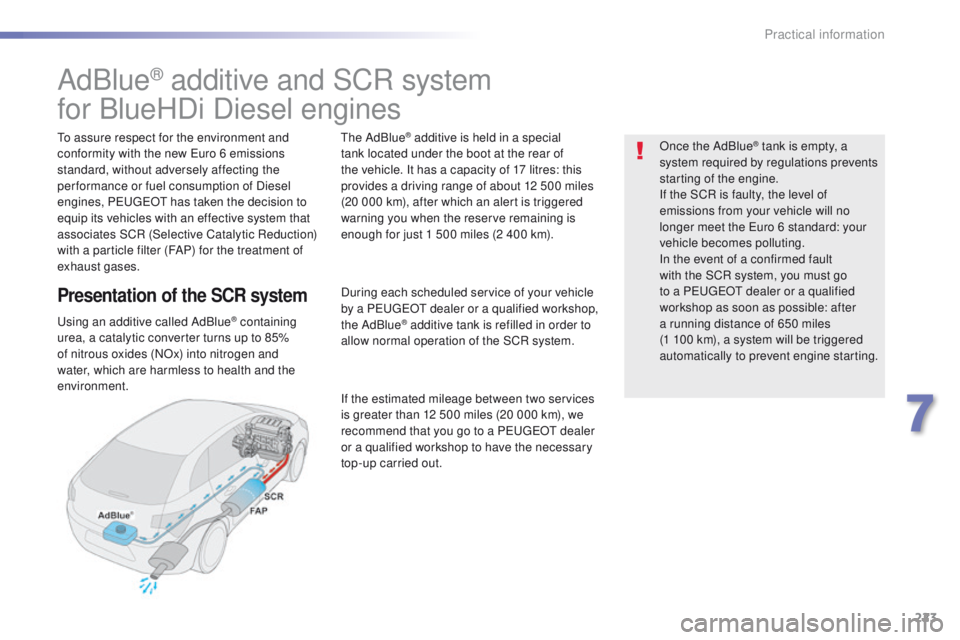
223
508_en_Chap07_info-pratiques_ed01-2016
AdBlue® additive and SCR system
for BlueHDi Diesel engines
to assure respect for the environment and
conformity with the new
eu ro 6 emissions
standard, without adversely affecting the
per formance or fuel consumption of Diesel
engines, P
e
uge
Ot
has taken the decision to
equip its vehicles with an effective system that
associates SCR (Selective Catalytic Reduction)
with a particle filter (FAP) for the treatment of
exhaust gases.
Presentation of the SCR system
using an additive called AdBlue® containing
urea, a catalytic converter turns up to 85%
of nitrous oxides (NOx) into nitrogen and
water, which are harmless to health and the
environment.
th
e AdBlue
® additive is held in a special
tank located under the boot at the rear of
the vehicle. It has a capacity of 17 litres: this
provides a driving range of about 12 500 miles
(20 000 km), after which an alert is triggered
warning you when the reserve remaining is
enough for just 1 500 miles (2 400 km).
During each scheduled service of your vehicle
by a P
e
uge
Ot
dealer or a qualified workshop,
the AdBlue
® additive tank is refilled in order to
allow normal operation of the SCR system.
If the estimated mileage between two services
is greater than 12 500 miles (20 000 km), we
recommend that you go to a P
e
uge
Ot
dealer
or a qualified workshop to have the necessary
top-up carried out. Once the AdBlue
® tank is empty, a
s
ystem required by regulations prevents
starting of the engine.
If the SCR is faulty, the level of
emissions from your vehicle will no
longer meet the
e
u
ro 6 standard: your
vehicle becomes polluting.
In the event of a confirmed fault
with the SCR system, you must go
to a P
e
uge
Ot
dealer or a qualified
workshop as soon as possible: after
a running distance of 650 miles
(1 100 km), a system will be triggered
automatically to prevent engine starting.
7
Practical information
Page 226 of 371
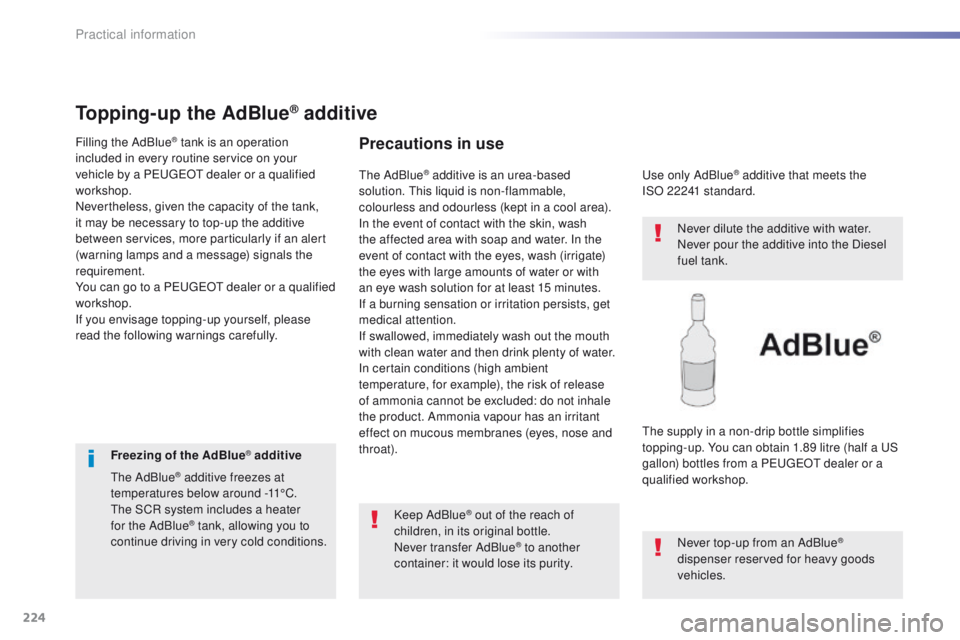
224
508_en_Chap07_info-pratiques_ed01-2016
Topping-up the AdBlue® additive
Filling the AdBlue® tank is an operation
included in every routine service on your
vehicle by a P
e
uge
Ot
dealer or a qualified
workshop.
Nevertheless, given the capacity of the tank,
it may be necessary to top-up the additive
between services, more particularly if an alert
(warning lamps and a message) signals the
requirement.
You can go to a P
e
uge
Ot
dealer or a qualified
workshop.
If you envisage topping-up yourself, please
read the following warnings carefully.Precautions in use
Keep AdBlue® out of the reach of
children, in its original bottle.
Never transfer AdBlue
® to another
container: it would lose its purity.
us
e only AdBlue
® additive that meets the
ISO
22241 standard.th
e AdBlue® additive is an urea-based
solution.
th
is liquid is non-flammable,
colourless and odourless (kept in a cool area).
In the event of contact with the skin, wash
the affected area with soap and water. In the
event of contact with the eyes, wash (irrigate)
the eyes with large amounts of water or with
an eye wash solution for at least 15 minutes.
If a burning sensation or irritation persists, get
medical attention.
If swallowed, immediately wash out the mouth
with clean water and then drink plenty of water.
In certain conditions (high ambient
temperature, for example), the risk of release
of ammonia cannot be excluded: do not inhale
the product. Ammonia vapour has an irritant
effect on mucous membranes (eyes, nose and
throat). Never dilute the additive with water.
Never pour the additive into the Diesel
fuel tank.
th
e supply in a non-drip bottle simplifies
topping-up. You can obtain 1.89 litre (half a
u
S
g
allon) bottles from a P
e
uge
Ot
dealer or a
qualified workshop.
Never top-up from an AdBlue
®
dispenser reserved for heavy goods
vehicles.
Freezing of the AdBlue
® additive
th
e AdBlue
® additive freezes at
temperatures below around -11°C.
th
e SCR system includes a heater
for the AdBlue
® tank, allowing you to
continue driving in very cold conditions.
Practical information
Page 355 of 371
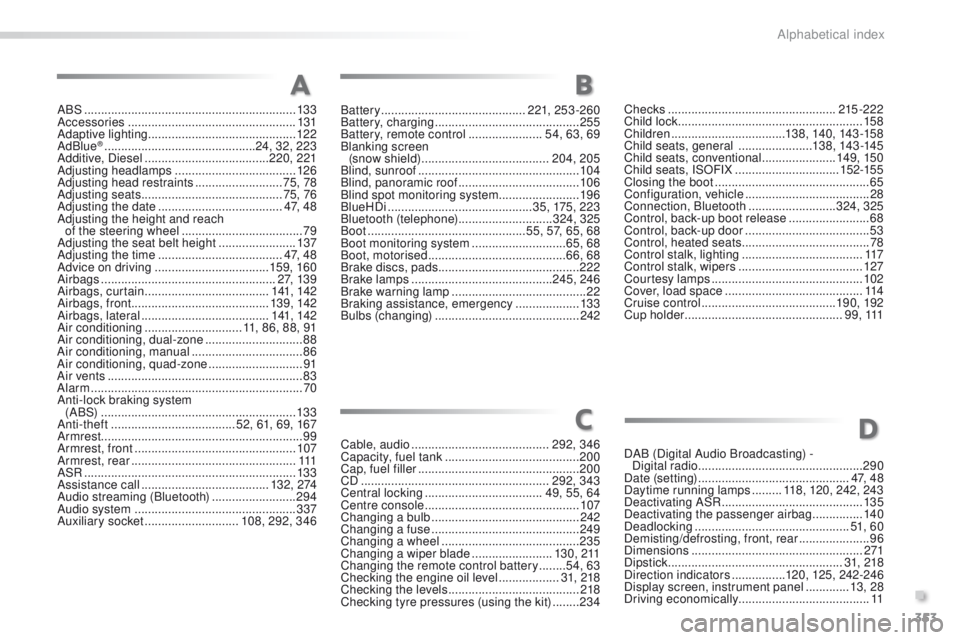
353
508_en_Chap11_index-alpha_ed01-2016
ABS ...............................................................13 3
Accessories .................................................. 131
Adaptive lighting
............................................ 12 2
AdBlue
® ............................... ..............24, 32, 223
Additive, Diesel ..................................... 220, 221
Adjusting headlamps
.................................... 126
Adjusting head restraints
..........................75, 78
Adjusting seats
.......................................... 75, 76
Adjusting the date
..................................... 4 7, 4 8
Adjusting the height and reach of the steering wheel
.................................... 79
Adjusting the seat belt height
.......................137
Adjusting the time
..................................... 4 7, 4 8
Advice on driving
.................................. 159, 16 0
Airbags
.................................................... 2 7, 1 3 9
Airbags, curtain
..................................... 14
1, 142
Airbags, front ......................................... 13 9, 142
Airbags, lateral
...................................... 141, 142
Air conditioning
............................. 11, 86, 88, 91
Air conditioning, dual-zone
............................. 88
A
ir conditioning, manual
................................. 86
Air conditioning, quad-zone
............................91
Air vents
.......................................................... 83
Alarm
............................................................... 70
Anti-lock braking system (A BS)
...............
........................................... 13 3
Anti-theft
..................................... 52, 61, 69, 167
Armrest
............................................................ 99
Armrest, front
................................................ 107
Armrest, rear
................................................. 111
AS
R
............................................................... 13 3
Assistance call
...................................... 13 2 , 2 74
Audio streaming (Bluetooth)
......................... 29
4
Audio system
................................................ 337
Auxiliary socket
............................ 108, 292, 346 Cable, audio
.........................................292, 346
Capacity, fuel tank
..............................
..........200
Cap, fuel filler
................................................200
CD
........................................................292, 343
Central locking
...................................49, 55, 64
Centre console
..............................................107
Changing a bulb
............................................242
Changing a fuse
............................................249
Changing a wheel
.........................................235
Changing a wiper blade
........................13 0 , 2 11
Changing the remote control battery
........54, 63
Checking the engine oil level
..................31, 218
Checking the levels
.......................................218
Checking tyre pressures (using the kit)
........234 DAB (Digital Audio Broadcasting) -
Digital radio
.................................................290
Date (setting)
...............................
..............4 7, 4 8
Daytime running lamps
.........118, 120, 242, 243
Deactivating ASR
..........................................13 5
Deactivating the passenger airbag
...............140
Deadlocking
..............................................51, 6 0
Demisting/defrosting, front, rear
.....................96
Dimensions
...................................................271
Dipstick
................
....................................31, 218
Direction indicators
................120, 125, 242-24 6
Display screen, instrument panel
.............13, 28
Driving economically ....................................... 11
Checks
...............
...................................
215-222
Child lock
...............................
........................
15 8
Children ............................... ...
13 8, 140, 143 -15 8
Child seats, general ......................
13 8, 143 -145
Child seats, conventional ......................149, 15 0
Child seats, ISOFIX
...............................15
2-155
Closing the boot
..............................................65
Configuration, vehicle
.....................................28
Connection, Bluetooth
..........................324, 325
Control, back-up boot release
........................68
Control, back-up door
.....................................53
Control, heated seats
......................................78
Control stalk, lighting
.................................... 11
7
Control stalk, wipers
.....................................127
Courtesy lamps
.............................................102
Cover, load space
.........................................11
4
Cruise control
........................................ 19
0, 192
Cup holder
...............................
................9 9 , 111
A
CD
B
Battery ........................................... 221, 253-260
Battery, charging ........................................... 255
Battery, remote control
...................... 5
4, 63, 69
Blanking screen (snow shield)
...............................
.......204, 205
Blind, sunroof
................................................ 104
Blind, panoramic roof
.................................... 10 6
Blind spot monitoring system
........................19 6
BlueHDi
........................................... 35, 175, 223
Bluetooth (telephone)
............................324, 325
Boot
............................................... 55, 57, 65, 68
Boot monitoring system
............................65, 68
Boot, motorised
......................................... 66, 68
Brake discs, pads
...............................
...........222
Brake lamps
...............................
...........245, 246
Brake warning lamp
........................................ 22
Braking assistance, emergency
...................13 3
Bulbs (changing)
...............................
............242
.
Alphabetical index
Page 366 of 371
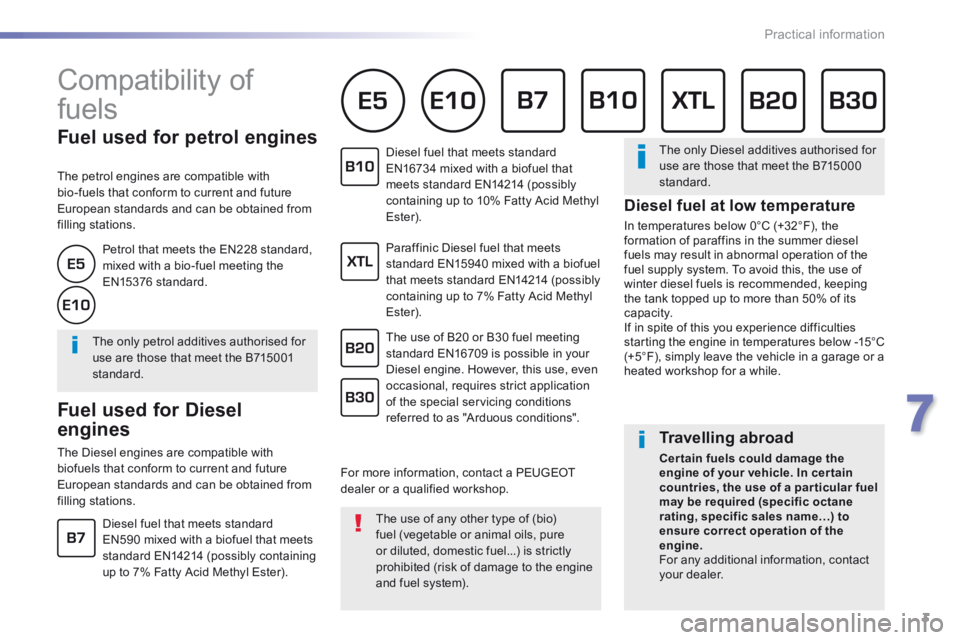
3
7
Practical information
508-additif_en_Chap07_info-pratiques_ed01-2016
Compatibility of
fuels
Fuel used for petrol engines
The petrol engines are compatible with bio-fuels that conform to current and future European standards and can be obtained from filling stations.
The use of any other type of (bio)
fuel (vegetable or animal oils, pure or diluted, domestic fuel...) is strictly prohibited (risk of damage to the engine and fuel system).
The only Diesel additives authorised for use are those that meet the B715000 standard.
Travelling abroad
Cer tain fuels could damage the engine of your vehicle. In cer tain countries, the use of a par ticular fuel may be required (specific octane rating, specific sales name…) to ensure correct operation of the engine. For any additional information, contact your dealer.
The only petrol additives authorised for use are those that meet the B715001 standard.
Fuel used for Diesel
engines
The Diesel engines are compatible with biofuels that conform to current and future European standards and can be obtained from filling stations.
Diesel fuel that meets standard EN590 mixed with a biofuel that meets standard EN14214 (possibly containing up to 7% Fatty Acid Methyl Ester).
Paraffinic Diesel fuel that meets standard EN15940 mixed with a biofuel that meets standard EN14214 (possibly containing up to 7% Fatty Acid Methyl Ester).
Diesel fuel that meets standard EN16734 mixed with a biofuel that meets standard EN14214 (possibly containing up to 10% Fatty Acid Methyl Ester).
The use of B20 or B30 fuel meeting standard EN16709 is possible in your Diesel engine. However, this use, even occasional, requires strict application of the special servicing conditions referred to as "Arduous conditions".
Petrol that meets the EN228 standard, mixed with a bio-fuel meeting the EN15376 standard.
For more information, contact a PEUGEOT dealer or a qualified workshop.
Diesel fuel at low temperature
In temperatures below 0°C (+32°F), the formation of paraffins in the summer diesel fuels may result in abnormal operation of the fuel supply system. To avoid this, the use of winter diesel fuels is recommended, keeping the tank topped up to more than 50% of its capacity. If in spite of this you experience difficulties starting the engine in temperatures below -15°C (+5°F), simply leave the vehicle in a garage or a heated workshop for a while.